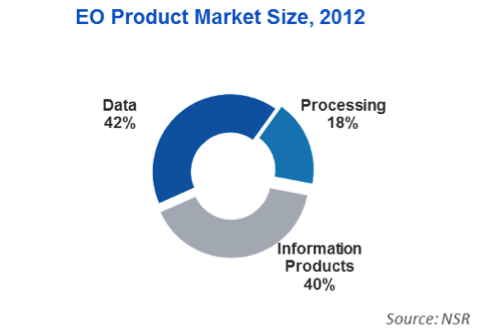|
Differentiation
Engine Restarting for EO Data
Oct 29th, 2013
by Stéphane
Gounari, NSR
Historically, differentiation in the EO data
market was achieved through spatial resolution
and spectrum. Since the data commercially
available reached the limit of shutter control
regulations (WorldView-1 in 2007), the race for
data product differentiation slowed down.
Companies providing 50cm resolution imagery
cashed-in, some of them developing their
spectrum capabilities, while other companies
worked at catching-up.
Now that more companies propose 50cm imagery,
incumbent players have to find new means of
differentiation to maintain their niche and the
revenues that come with it.
The recent calls to
lower the shutter control regulation limit are
now in line with incumbent future capabilities:
- DigitalGlobe (USA) claimed it would
immediately be able to address the new data
market thanks to satellites currently or
soon-to-be in-orbit with a resolution close
to 30cm (and unique spectrum).
- Thales Alenia Space (France) claimed it
would immediately be able to provide Optical
payloads with a resolution lower than 50cm.
It is likely only a matter of months before
shutter control regulations are lifted in the
main markets, especially as other imaging means,
such as Aerial and UAVs, are not constrained by
such regulations and provide imagery with a
resolution below 10cm, considerably
weakening the
legitimacy of such shutter control regulations
for satellites.
One could expect
Defense & Intelligence (D&I) organizations to be
the main clients of <50cm imagery. However the
largest
D&I organizations already have access to
commercial <50cm imagery;
therefore, they will not be at the origin of a
huge boost in orders. However, other vertical
markets such as Energy & Natural Resources (Oil
& Gas, Mining), Services and Industrial will
welcome this imagery. This will have
large
consequences on Processing and Information
Product markets
for two reasons:
D&I (and Public
Authorities) have a strong trend to
internalize such processes,
limiting the growth of the market, while
commercial verticals tend not to.
Historically, as D&I were the first and main
clients of the highest resolution imagery,
growth of data did not translate into huge
growth of Processing and Information
Products.
Second, the
value of
Processing and Information Products done
over imagery is correlated to the resolution;
the higher the resolution, the higher the
Processing and Information Products over
Data.


As large parts of D&I needs of <50cm imagery
are already satisfied, the ratio between the
growth of data markets and the growth of
Processing and Information Products will differ
greatly. While Processing market growth will be
restrained by other factors (such as
automation), Information Products will not.
Information Products will hugely benefit from
any weakening of shutter control regulations,
over time representing an
increasingly higher
share of the Satellite EO Industry.
Bottom Line
In a somewhat
typical situation,
major players are
competing on historical differentiation aspects,
while
new players work on proposing radically
innovative data products
(data products with very specific
characteristics):
- Video
Data Products:
Several companies announced such projects;
the most advanced is SkyBox Imaging (first
launches in 2013) with video data products
featuring 30 frames by second.
-
Meteorology Data Products:
Several companies
announced such projects; the most advanced
are GeoMetWatch (Hyperspectral Atmospheric
Sounders in GEO) and GeoOptics (atmospheric
sensing satellites).
The satellite EO
industry is therefore at the dawn of new period
of strong growth, driven by old factors pushed
further (spatial resolution and spectrum) and
brand new products.
|